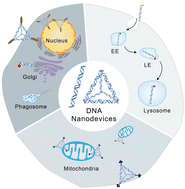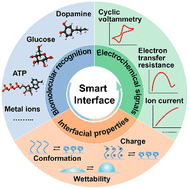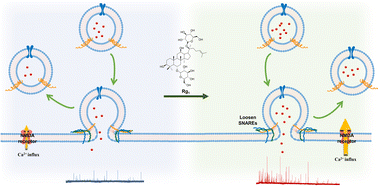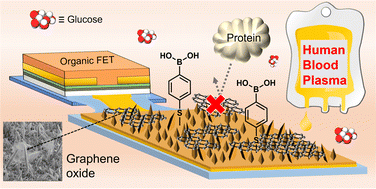Themed collection Sensors for Health

Carbon nanopores for DNA sequencing: a review on nanopore materials
Herein, we review the recent progress and achievements in carbon nanopore sequencing based on materials, including the selection of carbon nanomaterials, technologies for nanopore formation, and future perspectives of carbon nanopore sequencing.

Chem. Commun., 2023,59, 4838-4851
https://doi.org/10.1039/D2CC06517G
Recent advances in label-free imaging of cell–matrix adhesions
Recent advances in label-free imaging of cell-matrix adhesions by ECL microscopy and SPR microscopy are summarized, which are further followed by mapping analysis of cell adhesive force based on molecular tension fluorescence microscopy.

Chem. Commun., 2023,59, 2341-2351
https://doi.org/10.1039/D2CC06499E
Subcellular localization of DNA nanodevices and their applications
Schematic illustration of the subcellular localization of DNA nanodevices and their applications.

Chem. Commun., 2023,59, 3957-3967
https://doi.org/10.1039/D2CC06017E
Recent advances and challenges in developing electrochemiluminescence biosensors for health analysis
Recent advances and challenges in developing electrochemiluminescence biosensors for health analysis are reviewed.

Chem. Commun., 2023,59, 3507-3522
https://doi.org/10.1039/D2CC06930J
Fluorescence, ultrasonic and photoacoustic imaging for analysis and diagnosis of diseases
This feature article focuses on introducing three kinds of non-invasive imaging technology, i.e., fluorescence, ultrasonic and photoacoustic imaging, in which optical and/or acoustic signals are employed for diagnosing various diseases.

Chem. Commun., 2023,59, 2399-2412
https://doi.org/10.1039/D2CC06654H
Stimuli-responsive polymers for interface engineering toward enhanced electrochemical analysis of neurochemicals
Neurochemical monitoring can provide important insights into the chemical communications in the brain and neurological diseases.

Chem. Commun., 2022,58, 13171-13187
https://doi.org/10.1039/D2CC04506K
Progress in the past five years of small organic molecule dyes for tumor microenvironment imaging
The tumor microenvironment (TME) is the survival environment for tumor cell proliferation and metastasis in deep tissues.

Chem. Commun., 2022,58, 12642-12652
https://doi.org/10.1039/D2CC04975A
Advancements in microfluidics for skin cosmetic screening
Cosmetics can beautify the skin and assist the treatment of skin diseases. Some methods have been developed to replace animal experiments for cosmetic screening. The microfluidic skin chip is considered as a effective tool for in vitro tests.

Analyst, 2023,148, 1653-1671
https://doi.org/10.1039/D2AN01716D
Recent progress in homogeneous immunosensors based on fluorescence or bioluminescence using antibody engineering
Homogeneous immunosensors integrate the advantages of both biosensors and immunoassays; they include speed, high sensitivity, and accuracy.

Analyst, 2023,148, 1422-1429
https://doi.org/10.1039/D2AN01913B
Photonic Si microwell architectures for rapid antifungal susceptibility determination of Candida auris
The application of a photonic silicon chip-based optical sensor system for expeditious and phenotypic antifungal susceptibility testing of Candida auris is presented.

Chem. Commun., 2024,60, 1305-1308
https://doi.org/10.1039/D3CC04446G
Paper card-like electrochemical platform as a smart point-of-care device for reagent-free glucose measurement in tears
A novel paper card-like acting like a credit card to be inserted into a reusable polyvinyl chloride electrochemical fluidic system for furnishing all the reagents required for glucose measurement in artificial tears.

Chem. Commun., 2023,59, 4300-4303
https://doi.org/10.1039/D2CC06561D
A separable nanodevice enables multilayer imaging of diverse biomarkers for precise diagnosis
An acid-driven separable nanodevice based on a pH-sensitive structure and the like-catalytic hairpin assembly-assisted target amplification strategy for in situ multilayer imaging of extracellular pH and cytoplasmic miR-125a with high sensitivity.

Chem. Commun., 2023,59, 3419-3422
https://doi.org/10.1039/D2CC05825A
Ginsenoside Rg1 modulates vesicular dopamine storage and release during exocytosis revealed with single-vesicle electrochemistry
The effect of ginsenoside Rg1 on vesicular neurotransmitter storage and neurotransmitter release during exocytosis using single-vesicle electrochemistry.

Chem. Commun., 2023,59, 3087-3090
https://doi.org/10.1039/D2CC06950D
Non-enzymatic detection of glucose levels in human blood plasma by a graphene oxide-modified organic transistor sensor
An organic transistor-based sensor functionalized with graphene oxide and a phenylboronic acid derivative shows an accurate detectability for glucose in human blood plasma by the minimization of physical protein adsorption on the detection electrode.

Chem. Commun., 2023,59, 2425-2428
https://doi.org/10.1039/D2CC07009J
Potentiometric nanosensor for real-time measurement of hydrogen sulfide in single cell
This study demonstrates one potentiometric nanosensor for monitoring intracellular hydrogen sulfide with high selectivity, fast response, and excellent antifouling properties.

Chem. Commun., 2023,59, 1959-1962
https://doi.org/10.1039/D2CC06557F
A high-frequency QCM biosensing platform for label-free detection of the SARS-CoV-2 spike receptor-binding domain: an aptasensor and an immunosensor
High-frequency quartz crystal microbalance biosensing platforms were constructed using an aptamer and antibody as bioreceptors for fast and label-free SARS-CoV-2 RBD assay.

Analyst, 2023,148, 719-723
https://doi.org/10.1039/D3AN00008G
An anti-poisoning nanosensor for in situ monitoring of intracellular endogenous hydrogen sulfide
We develop MoS2 and quercetin functionalized nanoelectrodes with excellent electrocatalytic and anti-sulfur poisoning performance for H2S detection. Utilizing such nanosensors, the accurate quantification of intracellular endogenous H2S was achieved.

Chem. Commun., 2023,59, 1773-1776
https://doi.org/10.1039/D2CC06729C
Single-cell thermometry with a nanothermocouple probe
Herein, a nanopipette-based thermocouple probe that possesses high temperature resolution, rapid response, good reversibility and stability was constructed and successfully applied for single-cell temperature sensing.

Chem. Commun., 2023,59, 876-879
https://doi.org/10.1039/D2CC06110D
A biomarker-responsive nanoprobe for detecting hepatic ischemia-reperfusion injury via optoacoustic/NIR-II fluorescence imaging
A nanoprobe for detecting hepatic ischemia-reperfusion injury has been developed. The hepatic H2O2 removes the responsive moiety and transforms the quaternized pyridyl into an uncharged group with turn-on NIR-II fluorescence and optoacoustic signals.

Chem. Commun., 2023,59, 571-574
https://doi.org/10.1039/D2CC06031K
Monitoring mitochondrial nitroreductase activity in tumors and a hind-limb model of ischemia in mice using a novel activatable NIR fluorescent probe
The mitochondrial-targeted activated near-infrared fluorescent probe CS-NO2 is reported for monitoring nitroreductase in solid tumors and a hind-limb model of ischemia in mice.

Chem. Commun., 2022,58, 11438-11441
https://doi.org/10.1039/D2CC04112J
Near-infrared photothermally activated DNA nanotweezers for imaging ATP in living cells
Split aptamers were assembled into tweezers to construct a gold nanorod-based time-controlled nanosystem for the detection of intracellular ATP.

Chem. Commun., 2022,58, 8210-8213
https://doi.org/10.1039/D2CC02791G
A tight squeeze: geometric effects on the performance of three-electrode electrochemical-aptamer based sensors in constrained, in vivo placements
Electrochemical aptamer-based sensors are the first molecular monitoring technology that support real-time measurements in the living body. Electrode placement plays a key role in the performance of these sensors when they are deployed for intravenous measurements.

Analyst, 2023,148, 1562-1569
https://doi.org/10.1039/D2AN02096C
The enhancement of enzyme cascading via tetrahedral DNA framework modification
We report an enzyme conjugation method that can enhance the enzymatic activity by a tetrahedral DNA framework modification.

Analyst, 2023,148, 906-911
https://doi.org/10.1039/D2AN02097A
About this collection
With the development of the world population and increasing life expectancy, concerns toward human health are growing. The major obstacle to understanding the roles that biological molecules play in physiological and pathological events is a lack of reliable and efficient methods, due to a large variety of chemicals coexisting with dynamic variations and interacting with each other. In this cross-journal themed collection, guest edited by Yang Tian (East China Normal University) we cover themes including, but not limited to:
1) Fundamental investigations on precise construction and regulation of sensing micro/nano-interface toward health analysis.
2) Analytical approaches for accurate measurements of chemical expression in cells and living animals.
3) Precise imaging and biosensing of single cells.
4) Portable devices for health analysis based on stretchable sensors.
5) Artificial intelligence applications for health analysis.